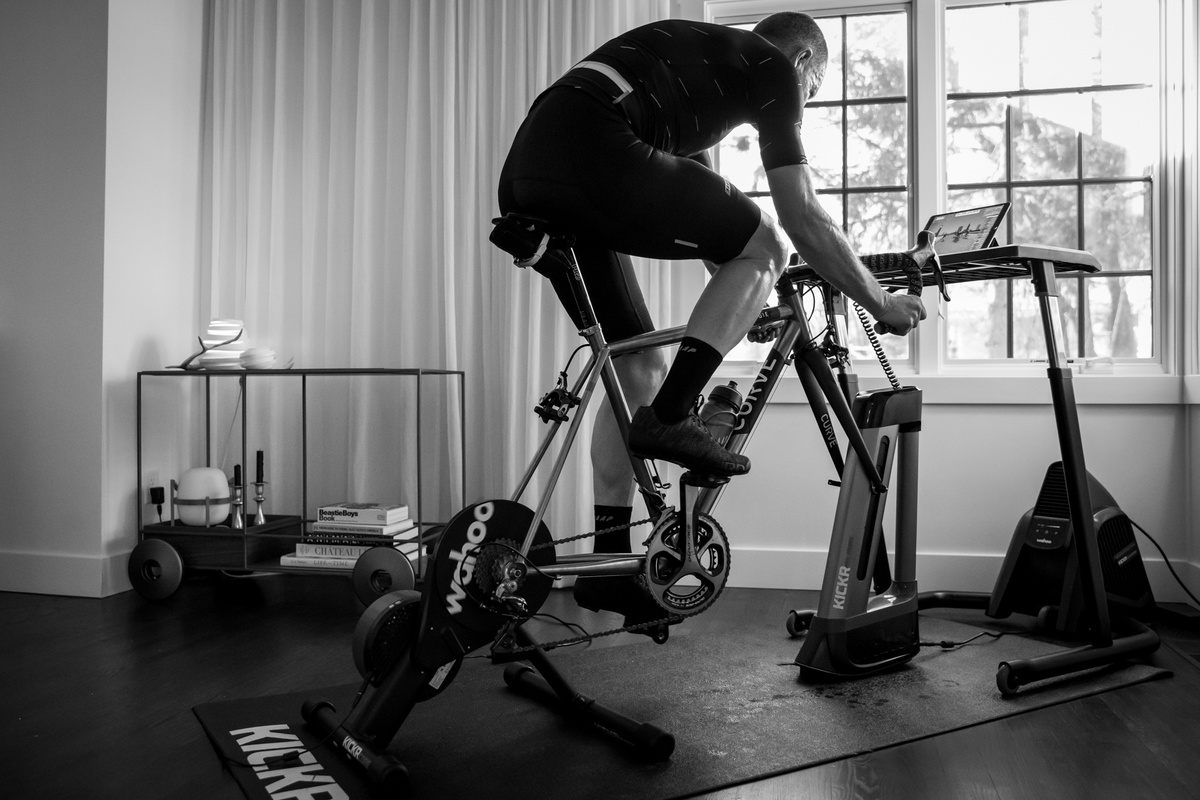La cadenza nel ciclismo è definita come il numero di rivoluzioni al minuto (RPM) che si completano a una determinata velocità. La potenza che si riesce a produrre sulla bicicletta è il prodotto della coppia (forza sul pedale) x velocità angolare (o velocità del pedale). Sulla base di questa formula è facile capire perché un aumento o una diminuzione della cadenza di pedalata influisce direttamente sulla potenza prodotta sulla bicicletta. Mentre molti ciclisti lavorano verso l’obiettivo desiderato di aumentare la loro potenza di soglia, potenzialmente un nuovo parametro di riferimento potrebbe essere quello di aumentare la loro efficienza ciclistica concentrandosi sul lavoro di cadenza.
La corsa e il nuoto sono sport in cui una forma ed efficienza scadente si manifesteranno rapidamente producendo risultati più lenti. Il ciclismo, d’altra parte, è più indulgente e può permettere alle persone di pedalare relativamente bene anche con una forma di pedalata scadente. Quando si osservano i ciclisti d’elite, la loro capacità di produrre movimenti ciclici fluidi sembra senza sforzo e molto di questo è attribuito al loro coordinamento neuromuscolare che è stato sviluppato nel corso degli anni in sella, così come all’attenzione ai dettagli nel migliorare la cadenza.
Aumentando la cadenza di pedalata a una data potenza, si produrrebbe meno forza sul pedale, quindi meno sforzo muscolare. Mentre si riduce lo sforzo muscolare, questo a sua volta aumenterebbe il tempo prima di arrivare all’affaticamento. Pedalare al 130% del proprio FTP a 30-40 RPM, la maggior parte delle persone troverebbe difficile se non impossibile mantenerlo per periodi superiori ai 90 secondi (alcune persone potrebbero non raggiungere nemmeno questo!) D’altra parte, se si cercasse di pedalare alla stessa percentuale ma a 130-140 RPM, la maggior parte dei ciclisti faticherebbe anche a superare uno o due minuti a causa dell’elevato sforzo cardiovascolare che questo sforzo richiederebbe. Perché? Questo accade a causa della diminuita efficienza a cadenze più elevate. In effetti, la maggior parte dei ciclisti è solo circa il 23% efficiente nel tradurre l’energia impiegata nella pedalata in potenza. Come si può aumentare questo? Pratica, pratica, pratica!
Sign Up for Wahooligan Content Newsletter
Coordinazione Neuromuscolare e Co-contrazione
Affinché si produca un movimento fluido e armonioso è necessaria una completa sincronizzazione di molti sistemi diversi che comunicano armoniosamente tra loro. Si può pensare come un’orchestra dove molti strumenti diversi suonano simultaneamente per produrre un brano musicale coeso. Questo non accade per caso, ma grazie alla coordinazione neuromuscolare. All’inizio, il suono è un po’ goffo e incoerente, ma con il tempo e attraverso la pratica diventa un suono conciso. Quando il tuo corpo esegue un lavoro ad alta cadenza, il tuo corpo comunica la contrazione e il rilassamento dei muscoli coinvolti fuori sincronia e ritmo. Questo aumento della comunicazione neuromuscolare è dovuto alla co-contrazione. La co-contrazione coinvolge i due gruppi di muscoli che circondano un’articolazione, flessori ed estensori, e la loro attivazione simultanea (che cercano di accorciarsi). Un esempio di co-contrazione sarebbe flettere il bicipite (flessore del gomito) e il tricipite (estensore del gomito) allo stesso tempo. Entrambi i muscoli si stanno contraendo, ma l’avambraccio non si muove.
Possiamo relazionare questo a una pedalata completa. Durante una rivoluzione completa del pedale, i muscoli non lavorano in modo indipendente. I muscoli della gamba, inclusi i quadricipiti (vasto laterale e mediale, retto femorale) e i muscoli posteriori della coscia (bicipite femorale (capo lungo e breve), semitendinoso e semimembranoso) lavorano tutti insieme per produrre un movimento fluido. Se lavorassero in modo indipendente, il tuo movimento sarebbe molto rigido e a scatti. Mentre i quadricipiti si allungano e producono forza sui pedali, i muscoli posteriori della coscia si accorciano e producono un movimento di trazione contro questa forza.
Perché Questo è Importante?
Se puoi migliorare la tua coordinazione neuromuscolare sulla bicicletta, allora puoi pedalare più forte… più a lungo. Incorporare incrementi di cadenza, esercizi di cadenza e mantenimenti ad alta cadenza frequentemente nell’allenamento può e migliorerà la tua coordinazione neuromuscolare. Questo aumento della coordinazione migliorerà la tua potenza in tutti gli intervalli, non solo nella parte alta. Nessuno ha mai pedalato più veloce pedalando in modo meno efficiente.
Sessioni per Migliorare la Cadenza di Pedalata:
Vuoi incorporare alcuni esercizi di cadenza nel tuo allenamento? Prova alcuni dei seguenti:
Pedalata di 60 minuti che include:
4-5 x 20-30 sec. incrementi di cadenza, 5-7 min. recupero
*Concentrati sull’attivazione del core e assicurati di non rimbalzare sulla sella della bicicletta.
Pedalata di 60 minuti che include 3 serie di:
30 secondi di incrementi di cadenza; recupero 1 minuto
45 secondi di mantenimento della cadenza al 100% FTP (alla cadenza più alta che puoi mantenere); recupero 1 minuto
60 secondi gamba singola
60 secondi recupero
60 secondi gamba singola
7 minuti recupero tra le serie
Pedalata di 60 minuti che include:
3 x 20 secondi incrementi di cadenza
3 minuti recupero tra ogni sforzo
5 x 60 secondi mantenimento cadenza 110-130rpm a ritmo tempo
4-5 minuti recupero tra gli sforzi
Lavorando regolarmente sulla tua cadenza di pedalata, diventerai un ciclista più efficiente, più veloce e più forte. Ti affaticherai meno e sarai in grado di andare più a lungo e con più intensità.




